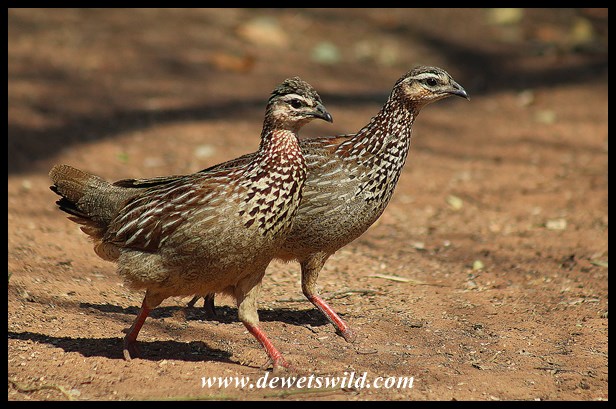Dendroperdix sephaena
Crested Francolins inhabit dense woodlands, often in riverine areas and with a sparse grass cover, and areas of thicket in more open savannas. They follow an omnivorous diet, including insects, seeds, leaves, shoots and fruits and berries according to whatever is most easily available in the season. Adults weigh from 240 to 460g and are about 33cm long.
During the breeding season, which stretches through spring and summer, Crested Francolins are usually seen in monogamous pairs or small family parties, forming mixed groups of up to 7 birds at other times. Their nests are shallow scrapes in the ground lined with soft plant material, well hidden among grass and shrubs. Clutches consisting of 3-7 eggs are incubated by the female for around 3 weeks. The chicks are precocious and leave the nest about two hours after hatching to start foraging with their parents.
The Crested Francolin is distributed over much of eastern and southern Africa, and considered of least concern by the IUCN. In South Africa it occurs commonly in the provinces of Kwazulu-Natal, Mpumalanga, Limpopo, Gauteng and North West.
Brett Hilton-Barber and Lou Arthur in their guide to birding in Kruger Park mentions an apparent symbiotic relationship between African Wild Dogs and Crested Francolins, in which the francolins are allowed to peck up scraps of leftover meat around wild dog dens without harrassment, and in turn provide advance warning to the pack of dogs whenever dangerous predators are close to their den.
The distinctive call of the Crested Francolin is often heard at sunrise in many of our favourite wild places.

























Such pretty birds, Dries. Thanks for the interesting info. 🙂
LikeLiked by 1 person
Thanks for visiting with us, Sylvia!
LikeLiked by 1 person
Another lesson learned! have you been blessed to see their collocation with the Wild Dogs?
LikeLike
We’ve never been lucky enough to see a wild dog den, AJ, but we’ll keep looking!
LikeLike
So interesting thankyou for all the info you always include in your posts…wonderfully informative
LikeLiked by 1 person
We’re very glad to know you enjoy it so, thank you Elle!
LikeLike
Hi guys. I have seen families of these on my sister’s farm. It is nice to think that wild dogs have a symbiotic relationship with these cute birds, and don’t eat them!
LikeLiked by 1 person
Nature so often surprises with a totally unexpected behavioral or physical characteristic, doesn’t it Kim!?
LikeLiked by 1 person
It really does.
LikeLiked by 1 person
Does the male and female have the same color on the feather suit? It reminds of a female pheasant.
LikeLiked by 1 person
If there are differences between the sexes, it is far too subtle for me to notice, John.
LikeLiked by 1 person
So similar to the many species of Grouse we have. Interesting relationship to the wild dogs! 🙂
LikeLiked by 1 person
I think they fill the same ecological niche here as the grouse would in the northern hemisphere.
LikeLiked by 1 person
I agree. Dogs and birds working together is interesting. I can see the birds coloring would be good for camouflage.
janet
LikeLiked by 2 people
Sometimes you get a huge fright out in our wild places when a hidden francolin suddenly explodes from under your feet!
LikeLike
I can imagine.
LikeLiked by 1 person
That is most interesting about the dogs and birds working together. I never would have thought…
LikeLiked by 2 people
Nature can be so surprising sometimes!
LikeLiked by 1 person